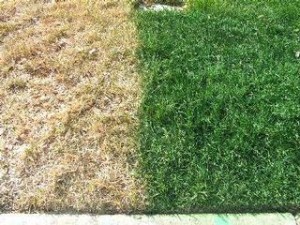Nov
Tips On Maintaining Your Non-Overseeded Lawn This Winter
As we move through the fall season many of you will choose the option to forgo overseeding this season to save some water. With the prime growing season behind us you’re going to start to see your lawn start to slow down. The days are becoming shorter and your warm season grass is starting to need less inputs. There are a couple areas where you can cut back this winter to save yourself money. I will go into detail what you need to maintain a non-overseeded lawn during the winter, and go briefly over an overseeded lawn watering and fertilizer schedule.
My first suggestion for those that will not be overseeding is to turn your irrigation clock off except on the day you will be watering. Having your lawn set up to automatically run certain days and times during the fall/winter will cause you to use much more water than your lawn can utilize.
A warm season grass needs night time temperatures in excess of 65 degrees to grow, and it’s doubtful we will have more than a couple days reaching that temperature during the next four months. Temperatures right now in the desert regions are hovering around 80 degrees for a high, but with the cool nights your lawn doesn’t need as much water as it does in the spring when it is coming out of dormancy. Between now and Thanksgiving, I suggest you water no more than once per week putting down about ¾” of water per week. In general a pop up sprinkler will apply between .3 to .4 inches of water every fifteen minutes. An impact sprinkler will apply between .2 and .25 inches in fifteen minutes. These numbers vary depending on water pressure, nozzles, and sprinkler type.
Ideally an irrigation cycle will move water down to a soil depth of 6-10” where the roots can utilize the water. Putting down ¾” of water should allow you to easily put a screw driver in the ground 10” after the sprinklers run. This is enough water to keep your grass alive between now and December. Once we receive our first frost you can cut the water back to once per month.
Your root system can utilize between ¾” and 1” of water a month during the winter to keep the plant healthy during the colder months. If the forecasts are correct and this is really going to be an El Nino year you may not need to turn on your irrigation system until the end of February. If you get an inch of rain between your monthly watering I would forgo watering all together for another 30 days. Since you will rarely be watering during the winter, I highly advise you keep your irrigation timer off except on the days you water. You don’t want to forget and put down water that the grass doesn’t need.
Since your lawn will not be actively growing during the winter it gives weeds a chance to push their way into your lawn. These can easily be managed with a weed and feed type fertilizer or pre-emergents like Barricade. You will want to look for labels that include the active ingredient Prodiamine. They make a granular and a foliar product. See the label for application instructions. This application needs to be made before the middle of November to be most effective.
Finally, there is no need to apply any fertilizer to your lawn during the winter months, however I like to put down a late fall application down such as 15-15-15, 0-0-22, 0-0-50 or a product high in potassium (third number on a fertilizer label) to give the plant strength during the winter. Since it won’t have any protective barrier besides the dormant turf a little fertilizer will go a long way.
For those of you with an overseeded lawn now is a great time to put down another fertilizer application. I highly suggest the Soil Burst 4-4-2, 15-15-15, or even a balanced fertilizer such as 21-7-14. Once the temperatures drop below freezing these granular fertilizers are slow reacting and the plant is most efficient with foliar type fertilizers. The more inputs you can put in now, the better. It is much more convenient to apply a granular fertilizer than it is to apply a foliar unless you have the right equipment.
Watering an established overseeded turf (over 28 days) requires much less water than one realizes. The cool weather and short days are perfect weather to grow ryegrass with minimal stress to the turf. Between now and the first frost I would water no more than two times per week for 15-20 minutes per cycle. A good tell tale sign for when to water is when you step on the grass and the footprints fail to respond. If you’re lawn is water stressed you will leave footprints in the lawn. This can easily be remedied with the next irrigation cycle.
When we get into December/January and the colder temperatures take effect, you can cut your water back to once every 5-7 days. This will depend on your root system and the height you keep your lawn. The shorter you mow your lawn, the more water it will need. Just because the lawn is overseeded doesn’t mean it needs an abundance of water. So save some water and money this winter by being smart with your lawn.
As always, keep sending me your grass questions, and check out my video blog below.
Click here to watch Mr. Wise Grass’ latest video on overseeding!
Jay


